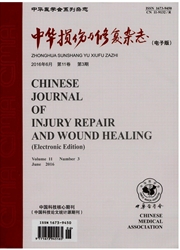

 中文摘要:
中文摘要:
目的研究医用可降解锌合金材料的体外抗菌性能及细胞相容性。方法大肠杆菌与金黄色葡萄球菌菌株分别与LB培养基混合,采用细菌比浊仪将浓度调节至1.0×108CFU/m L,在二氧化碳恒温箱内37℃下培养24 h,作为细菌原液;各取相同尺寸锌合金与钛合金棒,打磨、除去表面氧化层,在100%乙醇、蒸馏水中超声波震荡洗涤,后用环氧乙烷消毒,备用。(1)大肠杆菌/金黄色葡萄球菌分别与可降解锌合金、钛合金于LB培养基中共培养,培养0、2、4、6、8、12、24、48、72 h后分别用酶标仪测定其在600 nm波长下的吸光度值。(2)将可降解锌合金、钛合金置于含金黄色葡萄球菌的固体培养平板上,培养24、48 h后观察抑菌圈大小。(3)不同浓度锌合金浸提液培养L929细胞,培养1、5 d后观察细胞形态,并用CCK8法检测细胞增殖情况,计算细胞相对增值率(RGR)。(4)将小鼠胚胎成骨细胞前体细胞(MC3T3-E1细胞)接种于可降解锌合金、钛合金表面,培养2 d后观察细胞在不同材料表面的黏附生长情况。组间数据比较采用单因素方差分析(ANOVA)及t检验。结果不同时相点,大肠杆菌加锌合金共培养组的吸光度值明显低于单纯大肠杆菌培养组、大肠杆菌加钛合金共培养组,差异均有统计学意义(P值均小于0.05);不同时相点,金黄色葡萄球菌加锌合金共培养组吸光度值明显低于单纯金黄色葡萄球菌培养组、金黄色葡萄球菌加钛合金共培养组,差异有统计学意义(P值均小于0.05)。可降解锌合金周围出现抑菌圈,培养24 h后,锌合金圆柱体周围(4.38±0.40)mm范围内无菌落出现,培养48 h后锌合金圆柱体周围(4.75±0.44)mm范围内无菌落出现,培养24、48 h的抑菌圈大小比较差异无统计学意义(t=-1.10,P=0.31),而钛合金周围未出现抑菌圈。不同浓度锌合金浸提液培养组与阴性对照组,L929细胞细胞生长状况良好,
 英文摘要:
英文摘要:
Objective To study the antibacterial property and cytocompatibility of medical biodegradable zinc alloy in vitro. Methods Escherichia coli and Staphylococcus aureus strains were respectively mixed with LB culture medium, the concentration of 1. 0 × 108 CFU/mL was regulated by the bacterial turbidimetric instrument. The bacteria was cultured in carbon dioxide incubator of 37℃ for 24 h as bacteria original liquid. The same size of zinc alloy and titanium alloy ( Ti6Al4V) rods were prepared for experiment, the surface oxide layer was polished and removed, which was cleaned ultrasonically in 100%ethanol and distilled water, disinfected with ethylene oxide, standby. (1) Escherichia coli/Staphylococcus aureus strains were respectively co-cultured in LB culture medium with biodegradable zinc alloy, titanium alloy. The absorbance value at the time of 0、2、4、6、8、12、24、48、72 h after cultured at 600 nm wavelength was determined by enzyme-linked immunosorbent assay. (2) Zinc alloy and titanium alloy were respectively placed on Staphylococcus aureus strains solid culture plates, bacteriostatic circles were observed at 24、48 h after cultured. ( 3 ) L929 cells were cultured with different concentrations of zinc alloy extracts, cell morphology were observed at the time of 1、5 d after cultured, CCK8 method was used to detect the cell proliferation and cell relative rate of increment(RGR) was calculated. (4)The MC3T3-E1 cells were seeded respectively on zinc alloy surface and titanium alloy to observed adhesion and growth state 2 days after cultured. Single factor analysis of variance ( ANOVA) and t test were used to compare the data between the groups. Results The absorbance values of Escherichia coli and zinc alloy co-culture group were significantly lower than Escherichia coli culture group, Escherichia coli and titanium alloy co-culture group at different phase points, the differences were statistical significant(P values were less than 0. 05). The absorbance values of Stap
 同期刊论文项目
同期刊论文项目
 同项目期刊论文
同项目期刊论文
 Antibacterial properties and bioactivity of HACC- and HACC–Zein- modified mesoporous bioactive glass
Antibacterial properties and bioactivity of HACC- and HACC–Zein- modified mesoporous bioactive glass Selective laser sintering fabrication of nano-hydroxyapatite/poly-epsilon-caprolactone scaffolds for
Selective laser sintering fabrication of nano-hydroxyapatite/poly-epsilon-caprolactone scaffolds for 期刊信息
期刊信息
